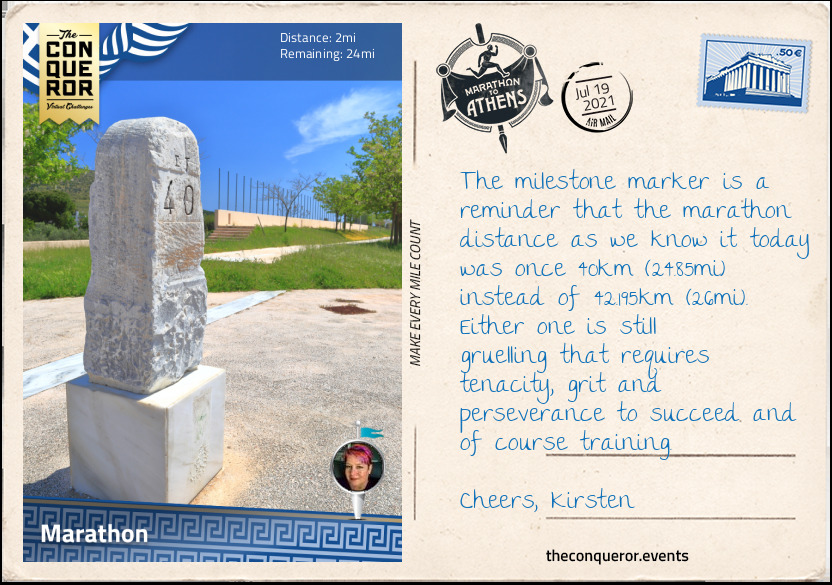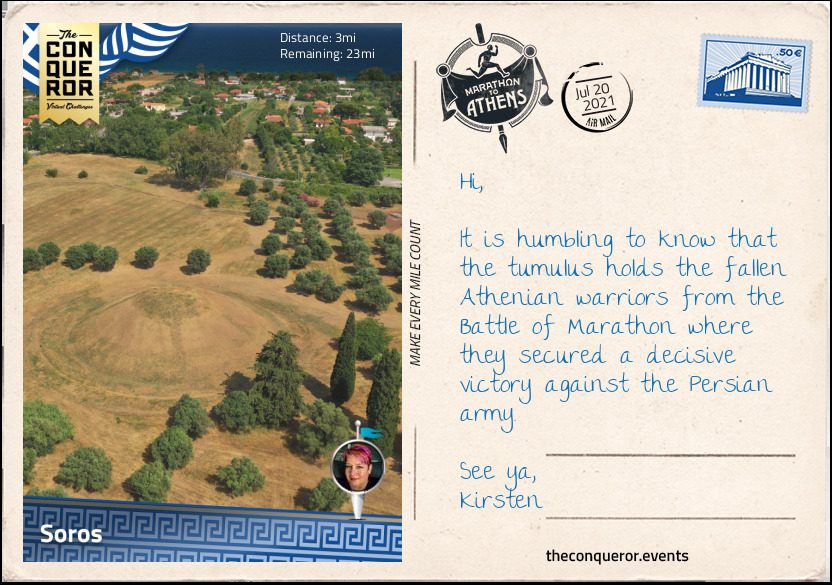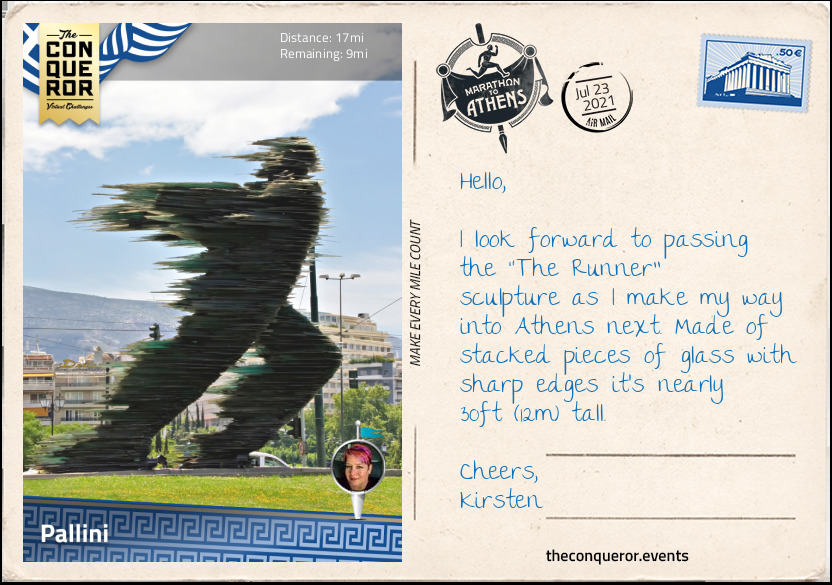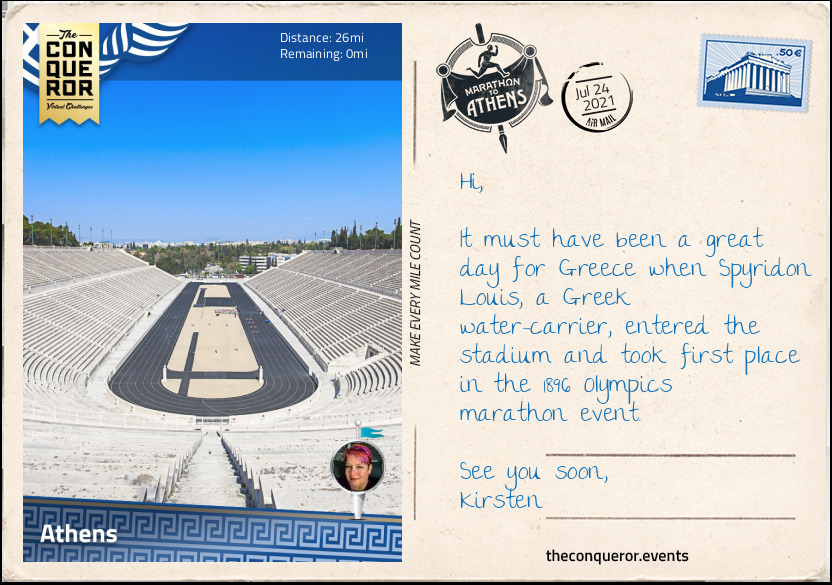This fall, I’m going to try doing my first marathon. In honour of that, I signed up for the Marathon to Athens virtual fitness challenge. This one is a bit longer than the 10 kilometres I’m training for, but it does take me 26.2 miles (42.2 km) on the legendary route of the original marathon, in Greece. I like a little bit of history along with my sweat.
Plus, take a look at the video on the right. The medal is awful pretty, and there’s a little coin hidden in the design. It’ll be a nice addition to my collection.
Speaking of which, I have now completed 10 challenges: Mount Fuji, Mount Everest, Pyramids of Giza, Cabot Trail, 2021 (custom challenge), English Channel, Inca Trail, Mount Kilimanjaro, New Zealand Alps to Ocean, and Marathon to Athens.
Postcards

The town of Marathon is synonymous with the road race referred to as marathon. Each year a Marathon to Athens road race takes place beginning here. Starting in Marathon it follows a southwest route parallel to the coast of Petalioi Gulf with a slight detour around the “Tumulus of the Marathon Warriors” before taking a west and then northwest direction into Athens ending in the Panathenaic Stadium. This is the route that I will be following on this journey completing the full marathon distance of 26.2mi (42.195km).
Marathon is a town in Attica, Greece largely known for its historic victory in 490BC when greatly outnumbered Athenians crushed the Persian army. This is also where the legend of Pheidippides’ run to Athens was also born. The story told is that Pheidippides was a hemerodrome, an Athenian day-courier who would run from location to location to deliver messages. He was sent from Athens to Sparta to request help, having to run a 300mi (480km) round-trip. Upon his return he ran from Athens to Marathon 24.85mi (40km) and came back to announce the victory in Marathon before collapsing from exhaustion and dying.
No one knows with certainty how much of Pheidippides’ story is real or if it was muddled with other events and subsequently interpreted a little differently when the story was transcribed. No matter though, it seemed to be enough of a reason to commemorate Pheidippides with a marathon distance race at the inaugural 1896 Summer Olympics in Athens. Since Greece was the birthplace of the Ancient Olympic Games it seemed appropriate that it should be host to the first modern Olympics.
The original Olympic Games were held in Olympia in Ancient Greece from around 776BC to 393AD. They were held in honour of Zeus, a mythological god in the ancient Greek religion and the ruler of the gods on Mount Olympus. The very first foot race was a 192m sprint called Stadion and it was the only event held at the Olympics for the first 13 games. The foot race expanded to double the length known as Diaulos at the 14th games. The Dolichos (long race) was added in the 15th games that equalled approximately 3mi (4.8km) in length, although it is debated since there are different accounts of the number of laps or lengths required. At most, the race may have been up to 5.6mi (9km) long.
The route begins outside the Marathon Stadium. Whilst large and barren I could imagine this on race day filled with professional athletes and amateur runners vying for their position at the start line. Runners would be abuzz with excitement and nerves, checking their sport watches for GPS connection, straightening their gear, ensuring their race bib is firmly attached, stretching, warming-up and mentally readying themselves for a gruelling 26mi (42km) race day.
Starting my journey, the route sloped away from the Start Area for the next 200m and entered the main road. Travelling alongside farmland the road gently ambles itself downhill for the next 2.6mi (4km) where I turn left to make my way towards Soros, the tumulus where the ancient Athenians were buried.
It may be a bit too soon for a meal but if I find somewhere to pick up some sweets, I’ll be sure to be looking for the delectable and syrupy baklava. It is a super sweet dessert made up of filo pastry, tightly packed ground nuts mixed with butter and sugar that have been soaked in honey syrup. I’m sure to have some sticky fingers and perhaps a little syrup dripping down my hand but for the indulgence it’ll be worth it.

As I ambled along Marathonomáchon road, which translates as Marathon battle, I imagined the event that took place here 2,500 years ago. At the junction I turned right to reach the carpark for the Marathon Archaeological Site and to the left of its entrance was a bronze statue of Miltiades, the Greek commander who brought victory at the Battle of Marathon. On the grounds of the archaeological site was the tumulus (burial mound) of the Marathon warriors, also known as ‘Soros’, who died on the battlefield.
Let’s roll back the time to 490BC and imagine the Persian fleet of 600 warships advancing across the Aegean Sea. Under the leadership of two commanders Datis and Artaphernes (who was the nephew of Darius, King of Persia) the ships sailed into Eritrea and completely decimated it before making their way into the Bay of Marathon and onto its shores. According to modern historians the Persian army consisted of approximately 25,000 infantry and 1,000 cavalry far outnumbering the Athenian army of 9,000 and the 1,000 Plataeans who aided them.
The Persians disembarked on the beach of Schinias next to the Great Marsh, whilst the Athenians took up defensive positions across the marsh blocking the exits. The Athenians’ intent was to hold off any advancement from the Persians while they waited for the Spartans to arrive (they arrived after the battle finished). Without their own cavalry the Athenians were at a great risk against the large numbers of Persian cavalry. However, due to reasons unknown the Persian cavalry was absent on the day the Athenians at the behest of their commander, Miltiades attacked.
Taking up a phalanx formation (a tightly packed rectangular formation), each Athenian was armed with a thrusting spear between 4.9-8.2ft (1.5-2.5m) in length, a wooden shield covered in bronze and a short sword approximately 24in (60cm) long. The commander, Militiades, extended the phalanx formation to the length of the Persian one weakening its centre by reducing its depth but maintaining full strength on the flanks.
Advancing at a steady pace to close the one mile (1.6km) gap between the two armies, the Athenians accelerated their pace when the Persian’s arrows rained upon them. Charging at full speed into the Persian army the flanks of the Persians crumbled and the archers with no armour or shields had no other means of protecting themselves. With no hand-to-hand combat experience the Persian flanks retreated and escaped back to their ships.
The centre of the Athenian formation fared less well. Being weaker at the centre they were up against the elite Persian units. Having to cross scrub vegetation their advancement was slowed down, exposing them to Persian archers for much longer than the Athenians in the flanks. The Persians successfully broke through the centre and for a brief period they thought they had won the battle.
However, the Athenians on the flanks abandoned their charge and turned to attack the Persians in the centre. The Persians gave up the fight and before they could be surrounded, they fled back to their ships. The Athenians gave chase and continued attacking on the beach as the Persians attempted to re-embark their ships.
The Athenians captured seven Persian ships and killed approximately 6,400 Persians whilst they sustained a loss of 192 Athenians and 11 Plataeans.
It was at this point that Pheidippides was deployed to run his marathon to Athens and declare victory at Marathon prior to collapsing from exhaustion and dying. To be fair to the legend himself he did run to Sparta return prior to this and wouldn’t have had much time for recovery.
The tumulus 32ft (10m) high mound was built at the end of the battle where the cremated remains of the 192 fallen Athenians were buried. Black-figure vases were dedicated to the fallen at the tumulus by their families which today are housed in the town’s archaeological museum two miles (3.4km) east of the tumulus. Near the museum is the smaller tumulus of the 11 fallen Plataeans.
The journey here was a circular route around the tumulus then back on Marathonomáchon to the main road. Turning left back onto the main road, I continued on a straight and flat section for the next 2mi (3.25km).
Famished, I pulled into a restaurant. Greek cuisine is scrumptious, filled with deep and tantalizing flavours from dips such as tzatziki (yoghurt, cucumber and garlic) and taramasalata (fish roe dip) to moussaka (layered aubergine with mince lamb topped with a bit of bechamel sauce and cheese). However, my all-time favourite is the Spanakopita, made of crispy layers of filo pastry filled with spinach and feta cheese and a nice side salad of chilled green bean salad with tomatoes and dill. I paired it with a glass of retsina, a Greek wine that “derives part of its flavour from exposure to tree resins, most generally pine resin” and is complementary to the strong flavour of feta cheese.

I continued southbound through the town of Nea Makri, known for its coastline and beaches and the village of Mati, a popular tourist destination with ferry access to explore nearby islands.
The route takes a southwest direction to Pikermi. The town has a paleontological site where 40 mammal species from the late Miocene era, about 8 million years ago, were discovered. The site was initially discovered by accident by Scottish historian, George Finley, in 1836 whilst he was looking for the remains of a temple. Three years later during excavations, a Bavarian soldier came across calcite crystals thinking they were diamonds. He handed the specimens over to zoologist Andreas Wagner in Munich who disproved the specimens as diamonds but instead recognised it as the maxilla (upper jaw) of a primate which was classified as the first primate specimen to ever be discovered. Fieldwork followed with many more discoveries until the early 1900s when it stopped for about 50 years. In the 1970s activity resumed for the next decade before stopping again for another 28 years. Activity began again when new sites were discovered in the Pikermi Valley. Since 2009, annual excavations have unearthed more than 2,000 specimens including mammals such as the hipparions, the three-toed horses that roamed the earth during the Miocene period.
Heading west, I arrived at the suburban town of Pallini. It is located in a plain between the mountains of Penteliko to the north and Hymettus to the south. The mountain elevations are between 3,300-3,600ft (1,000-1,100m).
Hymettus was an excavation site in the early 20th century where three structures were found. The larger one was identified as an altar. Several shards with inscriptions dedicated to Zeus were also found. It was hypothesized that the structure was a sanctuary of Zeus Ombrios (meaning Showery Zeus) where agricultural people would make offerings in favour of rain, especially during severe droughts. The first writings about the existence of the altar was by Pausanias, a 2nd century geographer who wrote about ancient Greece. His writings were supported by the excavation site where besides the inscribed shards, complete potteries and vessels that were used as offerings were also discovered in a hollowed area near the altar. It seemed that periodically the offerings were gathered from the altar to make space for new offerings and dumped into a nearby hole. These discoveries have given archaeologists a wealth of information who were able to deduce that the sanctuary was used for several centuries with the 7thC BC being the busiest period.
Mount Penteliko is fully surrounded by houses and two-thirds covered by forestry. What Penteliko is widely known for is its high-quality marble which was used for several structures in Athens, ie the Acropolis and Panathenaic Stadium. After a while the marble was exported to Rome for many of their ancient structures and sculptures. Today the ancient marble quarry is protected by law and only used for the restoration of the Acropolis.
The marathon course began an uphill climb from Nea Makri at around the 13th mile (21km), then continued uphill through Pikermi and Pallini. Building up an appetite with all the uphill work into Pallini I settled in at a tavern for a mini feast. Starting with a mixed olives appetiser and bread for dipping in olive oil, I moved onto a small fish, grilled whole, drizzled with lemon and oil dressing accompanied by a tomato salad with onions, green peppers, feta and olives and a side dish of herbed roasted potatoes cut into wedges. I finished with a slice of Karythopita, a spiced walnut cake.

Leaving Pallini the route commenced a steep ascent from the suburbs of Gerakas to Stavros Junction, followed by a steep descent into Agia Paraskevi Square. The route continued through the districts of Chalandri and Cholargos alternating between flat and downhill sections, beneath Calatrava Bridge, past the massive “The Runner” sculpture and finished in the Panathenaic Stadium in Athens.
The Panathenaic Stadium was originally built as a racecourse in the 6thC BC. Two centuries later a stadium made out of limestone was built on this site for the Panathenaic Games which differed from the Ancient Olympic Games. Whilst they both took place every four years, the Panathenaic Games gave prizes such as amphorae, large ceramic vessels filled with high quality olive-oil or drachmas (money) as a reward, whereas the Olympic Games awarded a garland of olive leaves. The Panathenaic Games lasted longer, dedicated a full day to poetry recitals, had a torch race and only allowed Athenians to take part unlike the Olympics where any male from Greece could take part. As prestigious as the Panathenaic Games were to the Athenians they were not as important as the Olympic Games.
The stadium was reconstructed in 144AD in marble quarried from Mount Penteliko near Pallini. It is the only marble stadium in the world today. By 4thC AD the festivals and games were banned and the stadium was abandoned. Falling into ruin, the marble was reused in other buildings. With the centuries passing the remains of the stadium was covered by vegetation until it was discovered during archaeological excavations in the 1800s.
Wanting to revive the ancient Olympic Games as a modern event, the stadium was rebuilt once again, in the same marble, just in time for the inaugural 1896 Modern Olympics. An estimated 80,000 spectators attended the event. It took another 108 years before the games returned to the Panathenaic Stadium when Athens hosted the 2004 Summer Olympics. The stadium hosted the archery event and was the finishing point for the marathon race event.
Walking through the stadium I could imagine the ancient games with chariot races, athletics and even musical events taking place as the spectators roared and cheered from the stands. On either side of the track’s bend are two identical double-headed statues with Apollo on one side and Hermes on the other. Both Apollo and Hermes are members of the 12 Olympians, the most important gods in Greek mythology.
At the entrance to the stadium to the far right is a statue of Georgios Averoff, the benefactor who sponsored the 1896 reconstruction, as tribute for his generosity. Opposite the stadium is a copy of Konstantinos (Kostas) Dimitriadis’ bronze statue of a discus thrower. What makes this statue important is that Kostas, a distinguished sculptor of Belgian-Greek heritage, competed in the 1924 Paris Olympics not as an athlete but as an artist. Art competitions were part of the Olympic events until 1948. During the competition Kostas presented the discus thrower statue in the Sculpturing category and won the Gold medal. The original statue is in Randall’s Island Park, New York City.
The original distance at the 1896 Olympics was set at 40km (24.85mi) based on the alleged distance Pheidippides ran from Marathon to Athens. The distance remained that way for both the 1900 and 1904 Olympics. However, in 1908 at the London Olympics the marathon distance was extended to 26.2mi (42.195km) starting at Windsor Castle and finishing in front of the Royal Box in the White City Stadium (a stadium that was specifically built for the 1908 games and has since been demolished). The extended distance was standardised in 1921 and since the 1924 Olympics onwards it has been the official marathon distance.
Fast forward to the 21st century and at least 800 marathons are held annually around the world. Although the majority of runners are recreational athletes there are many prestigious events that require a marathoner to meet a particular qualifying time in order to participate. The most prestigious is the Boston Marathon which is also the oldest marathon race in the world that started in 1897 the year after the very first modern Olympics.
It’s been wonderful to travel in the steps of marathon athletes and legendary Pheidippides but now I’m ready to hang up my shoes or at the very least take a load off my feet and have a final feast of Greek cuisine.
Ouzo is Greece’s national drink. With its aniseed flavour, this clear alcoholic beverage turns cloudy if mixed with ice or water. It is often served as an aperitif to open up the appetite. Sipping slowly, I prepared my tastebuds for an entrée of grilled Halloumi cheese. This brined cheese that’s similar in texture to mozzarella, imparts a deep salty flavour that mellows when grilled. It was drizzled with balsamic vinaigrette and accompanied by half chopped cherry tomatoes topped with oregano leaves and cracked pepper. For the main dish I chose a serving of Stifado, a slow-cooked beef stew in tomato sauce, with caramelized shallots atop potato puree. Finished off with a strong brew of Greek coffee as I reminisced about my journey.

